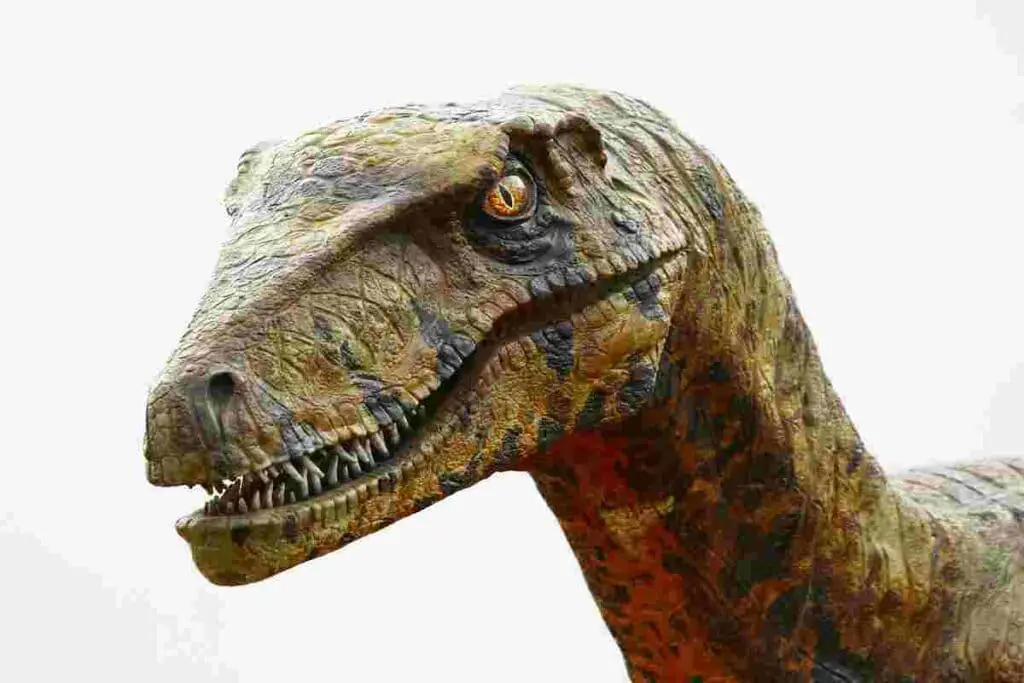If you look at a dinosaur diagram or even a life-sized recreation, one conspicuous feature in its absence is ears. You’re not expecting all dinosaurs to have big, bat-like ears, but you’ve never seen any traces of ears on a dino’s enormous skull. Did dinosaurs have ears?

Did Dinosaurs Have Ears?
Yes, dinosaurs did have ears, although they likely didn’t protrude. Nerve canals within a dinosaur’s skull allowed the creature to hear, as did the inclusion of a stapes (in some species), an inner ear bone that sends vibrations throughout the eardrum.
Paleontology brings forth questions concerning the auditory capabilities of dinosaurs that roamed the Earth during the Jurassic and Cretaceous periods. Analyses of dinosaur anatomy, such as that of Tyrannosaurus Rex and Triceratops, have revealed microscopic structures within fossils, leading to speculation about their hearing abilities.
Fossil evidence suggests that dinosaurs could have been equipped with auditory systems capable of detecting sound, despite a lack of visible external ears. These extinct reptiles, thus, likely relied on internal auditory systems much like modern-day reptiles, offering a juxtaposition between the human and dinosaur experience of hearing.
Table of Contents
It is erroneous to equate the lack of a recognizable ear structure to deafness. The evolutionary evidence points towards different forms of auditory systems in dinosaurs and their ability to perceive sounds. These realizations help in understanding the complex head structures, specifically the intricacies of dinosaur ears.
Communication methods, considered vital for survival, further support the notion of dinosaurs having a means to sense their environment. As species that thrived before the advent of mankind, being equipped with rudimentary hearing abilities would have been essential.
The investigation into dinosaur hearing and its relation to prehistoric evolution and communication methods continues to intrigue researchers. Though the exact anatomy of dinosaur ears remains elusive, scientists are piecing together evidence to get a fuller understanding of the lives and times of these awe-inspiring creatures.
If you’re curious to learn even more about dinosaur hearing, including how well the T. Rex could hear, then this is the article for you. There’s lots of great information ahead, so make sure you keep reading!
Did Dinosaurs Have Ears? What Did They Look Like?
As we talked about in the intro, ears are not a common feature you will see in dinosaur depictions, but that doesn’t mean they weren’t there. Most creatures have ears, and those that don’t will still hear in some form.
They just sense sounds rather than hear them.
As for what dinosaur ears could have looked like, experts aren’t sure. There’s a reason for that. Ears are comprised of soft tissue that makes our cartilage and skin. Unlike dinosaur bones and even feces, soft tissue does not fossilize well (Source).
Could there be an undiscovered fossil record out there showing us what dinosaur ears look like? Sure, anything is possible. Yet if such a thing exists, no paleontologists, amateur or professional, have found it yet.
That means we can only use context clues to guess what a dinosaur’s ears looked like. For instance, look at the creatures that evolved from dinosaurs. Reptiles such as crocodiles, snakes, lizards, and turtles have ears, but none that you can easily see.
Crocodiles feature an external auditory meatus visible only as a slit and then covered by an ear flap. If you didn’t know what you were looking at, you’d assume the slit was just a facial feature.
Snakes have an inner ear, but it lacks an eardrum. However, connecting the inner ear to the jawbone makes the snake feel vibrations as it slithers on the ground. As for lizards, their ear openings attach to the eardrums right under their skin. They hear better than snakes.
Turtles have no ears at all but rather internal ear bones that sense sounds and vibrations.
Birds, which are another close relative of some dinosaurs, have no conventional ears either. Instead, they feature ear openings shaped like a funnel on either side of their head.
Could Dinosaurs Hear and If So, How Well?
Alright, we’ve established that dinosaurs have ears, which means they must possess some hearing ability. The question is, is that hearing more like a snake or turtle in that it’s all about vibrations over sounds, or could dinosaurs hear full-fledged noises?
A 2007 publication of Science Daily points us in the right direction. The report cites research done by the University of Maryland, College Park. According to lead university researcher Robert Dooling, the ear structure of a dinosaur is much akin to that of a crocodile or a bird.
It’s believed that dinos relied mostly on vibrations, but hearing high-frequency sounds wasn’t out of the range of possibility. Dooling suggests that a dinosaur could hear at a frequency of 3 kilohertz.
Is this high? Not at all.
Tuna can hear at a frequency of 1.1 kHz and chickens at 2 kHz. Both animals have a worse hearing range than dinosaurs.
Dinos share their 3 kHz hearing range with animals like bullfrogs and goldfish.
Here’s a breakdown of other creatures that hear well, from the best hearing to the worst:
- Porpoise – 150 kHz
- Bottlenose dolphin – 150 kHz
- Beluga whale – 124 kHz
- Mouse – 79 kHz
- Cat – 77 kHz
- Hooded rat – 75 kHz
- Albino rat – 72 kHz
- Opossum – 64 kHz
- Gerbil – 60 kHz
- Sealion – 50 kHz
- Rabbit – 49 kHz
- Guinea pig – 49 kHz
- Hedgehog – 45 kHz
- Ferret – 44 kHz
- Dog – 44 kHz
- Sheep – 42.5 kHz
- Raccoon – 40 kHz
- Cow – 35 kHz
- Horse – 33.5 kHz
- Chinchilla – 33 kHz
- Human – 19 kHz
- Owl – 12 kHz
- Elephant – 10.5 kHz
- Parakeet – 8.5 kHz
- Cockatiel – 8 kHz
- Canary – 8 kHz
- Tree frog – 4 kHz
- Catfish – 4 kHz
To put it into perspective, we can hear at a rate of about 17 kHz better than dinosaurs. Our hearing is greatly outshined by many animals, though! (Source)
Could Dinosaurs Hear One Another?
You’ve seen in films like Jurassic Park and consumed other pop culture where dinosaurs would roar like Godzilla. More than likely, suggests this Scholastic article, the sounds that dinosaurs made consisted of them slapping their gigantic tails on the hard ground.
It wasn’t a quiet act, either. Scholastic says the sound could have produced 200 decibels of noise. Humans shouldn’t expose their ears to sounds over 130 decibels, as it can cause pain. Listening to a dinosaur slap its tail could have been literally deafening.
To a dinosaur that didn’t have great hearing, though, what effect did this kind of sound make? Could other dinosaurs hear it?
Possibly, yes. A 2021 article from Yale talked about research done on the inner ear of dinosaurs, especially the Anhanguera (a pterosaur like a pterodactyl), the Velociraptor, and the Hesperornis, a bird-like creature from the Campanian Age.
The researchers learned about its middle ear by doing CT scans on a 3D Hesperornis fossil kept in the Yale Peabody Museum of Natural History. It is the only fossil of its kind, so it’s fascinating stuff.
The inner ear had clusters, including one that could have been the Hesperornis’ cochlear system, which dictates the creature’s hearing range. According to the Yale research, this inner ear could have allowed the dinosaur to hear juvenile hatching calls as well as high-pitched sounds that indicated danger or another dinosaur’s location.
As a caveat, the research only seems to apply to certain dinosaurs besides the Hesperornis, namely archosaurs, which are referred to as ruling reptiles. In the archosaur’s family are crocodilians and birds.
Certain bird-like dinosaurs such as the Archaeopteryx and other pterosaurs and troodontids were likeliest to have these hearing clusters.
What About the T. Rex? How Well Could It Hear?
Fitting into none of the above categories is the T. Rex. You can imagine that this massive creature would have had amazing hearing, right?
At Chicago’s Field Museum is a preserved T. Rex fossil named Sue. Sue had a stapes or an inner ear bone. The stapes is a feature in human ears that’s also sometimes known as the stirrup.
The inclusion of the stapes indicates that T. Rex could hear sound vibrations and then send those to its eardrum to make out noises. (Source)
Evolutionarily, it makes sense for the T. Rex to be able to hear well as much as it does for its prey to hear. A prey could detect an incoming T. Rex and find safety or try to anyway. For those that weren’t so lucky, the mighty T. Rex could rely on its hearing to track down its next meal.
What Senses Did Dinosaurs Have? How Does This Compare to Modern-Day Animals?
We as humans have at least five senses: hearing, taste, smell, touch, and sight. Some experts believe humans might have between 14 and 20 senses, but we’ll stick with the basics.
How many of these senses did dinosaurs have? What about the animals that evolved from dinosaurs and exist today? Let’s explore.
Sight
Dinosaurs certainly had the gift of sight. Depending on the dino’s eye placement, though, their site was excellent, so-so, or poor.
Eye placement was anything but random, as it was an evolutionary development.
For example, the Pachycephalosaur had eyes on either side of its skull. Being a plant-eater, the dinosaur needed to see threats so it could react quickly, and its eye placement allowed for that, as did its depth perception.
T. Rex’s eyes were closer together with a longer optic lobe than even we humans today have. Its fantastic sight, combined with its hearing and a heightened sense of smell, made the T. Rex a highly successful predator.
Binocular vision is what you’ll find in today’s alligators, but the Allosaurus and other carnosaurs had it first. This angled vision allows a creature to turn in on its prey and strike when the moment is right.
Smell
Smell is integral to survival. A dinosaur could smell rotten food and avoid it or pick up on the scent of blood and know that trouble might be afoot. Carnosaurs had advanced scent abilities, although the formidable T. Rex outshined theirs.
One modern-day animal that’s believed to have come from dinosaurs, the turtle, might lack nostrils, but it has barbels for scent detection. Barbels in turtles are small bumps below the chin that are filled with nerves.
They allow a turtle to smell prey and other scents both when in water and when out.
Taste
Could dinosaurs taste their food? A 2014 article in Ars Technica suggests that yes, they could. The article discusses research done by Harvard University postgraduate Maude Baldwin.
Baldwin found that the ability of a creature to detect sweetness in food has to do with T1R genes. By combining T1R2 and T1R3 genes, you get a sweet taste, while the combo of T1R1 and T1R3 dictates savory tastes.
Apparently, according to Baldwin’s research, dinosaurs could once enjoy the savory flavor of flesh as they chomped into their prey. What happened was that the birds that came from theropods, such as chickens, didn’t have the T1R2 gene to taste sweetness.
The reason? Chickens didn’t eat anything sweet, so why keep the gene? Yet hummingbirds, which have a much sweeter diet, by comparison, need that gene. That’s why hummingbirds can mutate their T1R1 and T1R3 genes even today.
Conclusion
Dinosaurs had ears, although not like we’d imagine them. The sense of hearing a dinosaur possessed was believed to be decent at best for some species and perhaps sharper in others. Dinosaurs also had other senses, from taste to smell and sight, especially the T. Rex!
